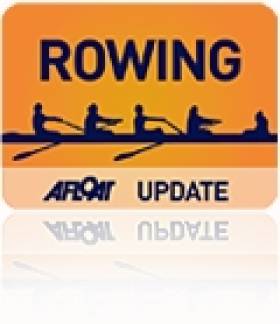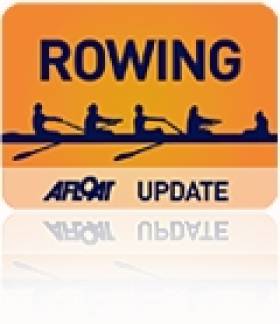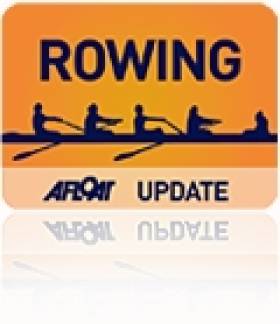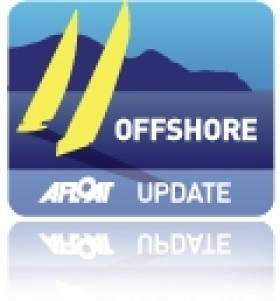Displaying items by tag: Jacques
# ROWING: A team of 13 Ireland hopefuls will travel to the World Junior Championships this season. Hilary Shinnick and Bridget Jacques team up in a promising junior double scull, and Bernadette Walsh will represent Ireland in the single scull in Lithuania.
Ireland will also take big teams to the Coupe de la Jeunesse in Lucerne, Switzerland, in August and the Home International Regatta in Nottingham in July.
| Junior World Championships, Trakai, Lithuania (7-11 August) |
|---|
| JW 1X Bernadette Walsh (Skibbereen RC) |
| JW 2X Hilary Shinnick (Fermoy RC), Bridget Jacques (Belfast BC) |
| JW 4X- Fiona Murtagh (Galway RC), Leonie Hamel (Cork BC), |
| Erin Barry (Bann RC), Jasmin English (Belfast BC) |
| JM 2X Andy Harrington (Shandon BC), Jack Casey (Shandon BC) |
| JM 4X- Paddy Hegarty (Skibbereen RC), John Mitchel (Lee RC), |
| David O’Malley (St Michaels RC), Conor Carmody (Shannon RC) |
| Coupe de la Jeunesse, Lucerne, Switzerland (2-4 August) |
| JW 1X Phoebe Mulligan (Portora BC) |
| JW 2X Megan McLaughlin (Cork BC), Claire Beechinor (Cork BC) |
| JW 4X- Kara O’Connor (Muckross RC), Eimear Lambe (Commercial RC), |
| Laura Kilbane (Cork BC), Zoe Hyde (Killorglin RC) |
| JM 1X Gareth McKillen (RBAI RC) |
| JM 2X William Yeomans (Commercial RC), Daniel Buckley (Lee RC) |
| JM 4X- Matthew Ryan (Skibbereen RC), Rory O’Sullivan (Lee RC), |
| Evan Stone (Lee RC), Stephen Murphy (Cork BC) |
| The following two crews will undergo further assessment before making a final decision for the Coupe de la Jeunesse team. |
| JM 4- Kevin Fallon (St Josephs RC), Jack Smyth (St Josephs RC), |
| David Keohane (Presentation), Brian Keohane (Presentation) |
| JW 4- Lauren McHugh (Shannon RC), Clodagh Scannell (Shandon BC), |
| Daisy Callanan (Shandon BC), Ruth Gilligan (Shannon RC). |
Home International, Nottingham, July 27th
Men – Junior, Sweep: C Hennessy, L Carroll, E Murray, K Anderson, R McKenna, A Chadfield (plus four to be chosen). Sculling: N McCarthy, E Whittle, K Keohane, D Synnott, S Kearney (plus two to be decided). Women – Junior, Sweep: V Sheehan, Z Madden, K Healy, E Coll, H McCarthy, A Luke (plus four to be chosen). Sculling: S Murphy, K Turner, C O’Sullivan, C Kelly, Z Sohun, A Griffin (plus one other).
# ROWING: The Rowing Ireland talent identification programme run by Nathan Adams in Belfast provided the fastest female and male single scullers at the Lagan Scullers’ Head of the River on Saturday. Up-and-coming talents Gareth McKillen and Bridget Jacques topped the rankings. A Belfast Boat Club/RBAI composite coxed quadruple scull was the fastest crew of the day.
Lagan Sculler’s Head of the River, Belfast, Saturday (Selected Results)
Race One: 1 Bann women’s senior quadruple sculls 12:39.8, 2 Belfast BC women sen quad 12:41.8, 3 RBAI junior single sculls (G McKillen) 13:03.1, 4 BBC/Portora masters double sculls 13:03.8, 5 BBC senior single (Wray) 13:05.9, 6 Lagan sen single (Darby) 13:06.3; 9 Portadown nov single (McKeown) 13:34.1; 15 Bann wom nov coxed quad 14:02.6.
Race Two: BBC/RBAI men sen quad 11:04.5, 2 Lagan Scullers’ men sen quad 11:46.9, 3 Methodist College jun 18A double sculls 12:38.9, 4 Lagan Scullers’ Masters single (Darby) 13:03.7, 5 RBAI jun 16 coxed quad 13:04.7, 6 Coleraine AI double sculls 13:08.1; 8 Portadown inter single (McKeown) 13:30.4; 9 Bann women’s sen double 13:36.0, 15 Bann women’s jun 16 coxed quad 14:16.7.
Race Three: 1 Methodist College jun 18A quad 11:53.8, 2 Coleraine AI jun 18B coxed quad 12:32.8, 3 Methody quad (time only) 12:42.1, 4 BBC/Lagan Scullers’ quad (mixed, time only) 12:54.5, 5 Methody women’s jun 18A quad 13:29.4, 6 Belfast BC women’s sen single (B Jacques) 13:49.6; 8 Bann women’s jun 16 double 14:13.8; 16 BBC women’s nov single (Turner) 14:50.5; 17 Portadown women’s jun 18A quad 14:57.6.
Jacques and Walsh Push Their Way Into Contention at Newry Rowing
| Rowing Ireland |
|---|
| 5000m Time Trial |
| 25th November 2012 |
| HP Team |
| Nov 2012 |
| Sex W |
| Values |
| Row Labels Time Senior % GMT Age % GMT |
| Sanita Puspure (Old Collegians BC) HW 21:13.3 83.4% 83.4% |
| Claire Lambe (UCD) LW 21:40.9 84.6% 84.6% |
| Amy Bulman (UCDBC) LW 22:02.4 83.2% 83.2% |
| Bridget Jacques (Belfast BC) WJ18 22:20.8 79.2% 84.7% |
| Denise Walsh (Skibbereen RC) LWU23 22:24.6 81.8% 83.9% |
| Sinead Dolan (DULBC) LWU23 22:41.3 80.8% 82.8% |
| Hilary Shinnick (Fermoy RC) WJ18 22:41.3 78.1% 83.4% |
| Siobhan McCrohan (Tribesmen RC) LW 22:44.1 80.6% 80.6% |
| Kate O'Brien (SMRC) HWU20 22:46.1 77.8% 79.6% |
| Cliona Hurst (NUIGBC) LW 23:11.0 79.1% 79.1% |
| Bernadette Walsh (Skibbereen RC) WJ18 23:21.2 75.8% 81.0% |
| Jasmin English (Belfast BC) WJ17 23:24.4 75.7% 80.8% |
| Aoife Leahy (QULBC) LWU23 23:24.6 78.3% 80.3% |
| Phoebe Mulligan (Portora BC) WJ18 23:32.3 75.2% 80.4% |
| Aifric Keogh (NUIGBC) HWU23 23:35.5 75.1% 76.8% |
| Claire Beechinor (Cork BC) WJ16 23:45.4 74.5% 79.6% |
| Hannah McCarthy (St. Michaels RC) WJ18 23:59.5 73.8% 78.8% |
| Kara O'Connor (Muckross RC) WJ16 24:07.7 73.4% 78.4% |
| aisling Rodger (Commercial RC) WJ17 24:13.8 73.1% 78.1% |
| Zoe Hyde (Killorglin RC) WJ16 24:14.9 73.0% 78.0% |
| Laura Kilbane (Cork BC) WJ16 24:16.2 73.0% 77.9% |
| Ruth Gilligan (Shannon RC) WJ18 24:22.0 72.7% 77.6% |
| Eimear Lambe (Commercial RC) WJ16 24:29.7 72.3% 77.2% |
| Daisy Callanan (Shandon B.C.) WJ18 24:31.8 72.2% 77.1% |
| Alice Beacom (Portora BC) WJ16 24:51.0 71.3% 76.1% |
| Erin Barry (Bann RC) WJ16 24:52.5 71.2% 76.0% |
| Ellie Sherin (St. Michaels RC) WJ18 24:57.3 71.0% 75.8% |
| Sarah Murphy (St. Michaels RC) WJ16 25:02.0 70.7% 75.6% |
| Clodagh Scannell (Shandon B.C.) WJ18 25:13.7 70.2% 75.0% |
| Erin Coll (Shannon RC) WJ16 25:24.7 69.7% 74.4% |
| Helen Ryan (Shannon Rowing Club) LW 25:35.2 71.7% 71.7% |
| Clodagh O'Sullivan (Shandon B.C.) WJ16 25:44.5 68.8% 73.5% |
| Chloe Finlayson (Portora BC) WJ16 25:46.4 68.7% 73.4% |
| Megan Blackburne (Fermoy RC) WJ18 26:01.0 68.1% 72.7% |
| Elizabeth Clarke (Portora BC) WJ16 26:28.5 66.9% 71.4% |
Dubois, who also partnered Mike in the 2007 Transat Jacques Vabre, will join him once again for the legendary French race from Le Havre, France to Puerto Limon, Costa Rica.
Golding, who recently signed a two year sponsorship agreement with Gamesa, a global wind power technology leader, has been overseeing a major optimisation of the yacht that will be dedicated by HRH The Princess Royal at the Southampton Boat Show on Tuesday 20 September 2011.
This will be Golding's seventh consecutive participation in the double-handed Jacques Vabre Race which takes place every two years and is considered the first major event in the Vendée Globe preparation cycle.
"Bruno and I have known each other for many years and I trust him completely as co-skipper on this my first race for Gamesa. As our sailmaker, Bruno and his team at North Sails France provide the real "engines" for Gamesa by providing hi-performance sails that are 'at the same time' fast, efficient and yet strong enough to race around the world. He has a totally unique perspective and knowledge, which I value greatly. As our unofficial 'sail coordinator' his knowledge of the boat and my style of sailing will have a direct impact on our potential in the Vendée Globe."
Always in the upper rankings and many times on the podium, a win in the Transat Jacques Vabre race has eluded Golding. "Clearly we are competing against some new boats this year plus we have been away from the IMOCA circuit for the past two years – however I remain confident that with our newly optimised boat and our combined experience onboard we will be a serious contender for a win in 2011." commented Golding earlier today.
Dubois, who is the Managing Director of North Sails France, commented, "It is a great pleasure for me to sail with Mike again. We have done many races together over the past 10 years including the 2007 TJV. We know each other quite well and do not have much work to do to get along on an IMOCA 60."
































































